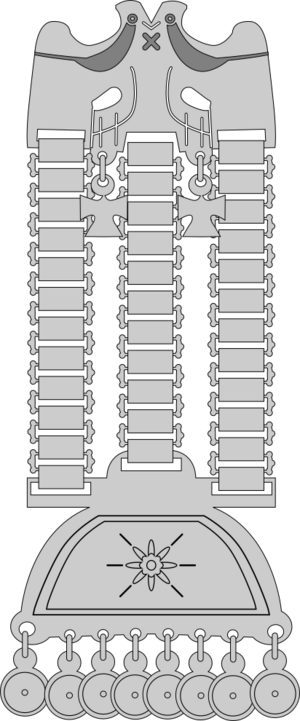Mapuche silverwork facts for kids

Mapuche silverwork is a very famous part of Mapuche culture. These beautiful silver pieces are worn as adornments or jewelry. While some designs have changed over time, many traditional styles have remained the same.
Contents
History of Mapuche Silverwork
Gold Adornments Before Silver
Long ago, the Mapuche people had a strong connection to gold. They used gold for jewelry even before the Inca Empire expanded into their lands.
When the Spanish arrived in Chile in the 1500s, they saw Mapuche people wearing many gold ornaments. Historians believe that the Mapuche mined gold in areas south of the Itata River. This was even beyond the borders of the Inca Empire.
However, much of this gold was taken by the Spanish during their conquest. Local stories say that Mapuche people also hid their gold from the Spanish. Gold mining became very dangerous for the Mapuche. Many died working in the mines for the Spanish. Because of this, gold mining became a taboo (something forbidden) among the Mapuche during colonial times. Mining gold was even punished by death.
How Silverwork Developed
In the late 1700s, Mapuche silversmiths (artists who work with silver) began making a lot of silver jewelry. This increase in silverwork happened after important peace agreements. Treaties like the 1641 Parliament of Quillín and the 1726 parliament of Negrete helped reduce fighting between the Spanish and Mapuche. This allowed more trade to happen.
During this time, Mapuche people started selling their goods, like cattle and horses, for silver coins. These coins, often from the famous Potosí silver mines in South America, became the raw material for Mapuche silversmiths, called rüxafe. By the 1700s, silver had taken the place of gold in Mapuche culture.
Some old Mapuche silver pendants still have unmelted silver coins in them. This helps modern researchers figure out when these pieces were made. Most of the silver came from outside Mapuche lands. This is why there are not many Mapuche place names related to silver (liqen) compared to those related to gold (milla).
Mapuche silver jewelry has many different designs. These designs often showed which reynma (family), lof mapu (land), or specific lonko (chief) or machi (spiritual leader) they belonged to. While fashion changed some designs, those linked to Mapuche beliefs and spirituality stayed mostly the same.
The late 1700s and early 1800s were the best time for Mapuche silversmithing. Most important Mapuche chiefs in the 1800s had at least one silversmith. Later, a war in 1869 between Chile and the independent Mapuche people caused a severe famine. A smallpox epidemic made things even worse. Because of this, some Mapuche people had to sell their precious silver jewelry to buy food.
By 1984, a Mapuche scholar named Carlos Aldunate noted that there were no silversmiths left among the Mapuche people.
What Mapuche Silverwork Looks Like
Mapuche silver adornments have a special look. A common design features three separate columns of flattened silver links. These columns are joined together by square links.
At the top of these columns, holding them together, is often a flat figure of a two-headed bird. At the bottom, there is usually a flat semicircle or trapezoid shape. Small silver disks often hang from the base of this shape. People would wear these beautiful pieces hanging from their neck down their chest.
See also
 In Spanish: Platería mapuche para niños
In Spanish: Platería mapuche para niños


